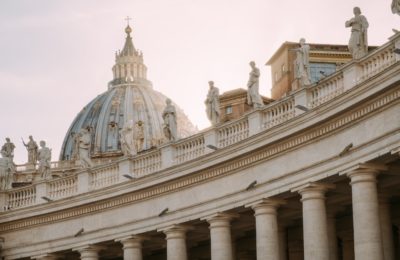Testimonies for the Synod – Mary Rice Hasson
October 17, 2018 | Published first in First Things: Letters from the Synod
LETTERS FROM THE SYNOD-2018: #10
REPORTS AND COMMENTARY, FROM ROME AND ELSEWHERE, ON THE XV ORDINARY GENERAL ASSEMBLY OF THE SYNOD OF BISHOPS
TESTIMONY FOR THE SYNOD
Mary Rice Hasson, J.D., is director of the Catholic Women’s Forum and the Kate O’Beirne Fellow in the Catholic Studies Program at Washington’s Ethics and Public Policy Center. As the Synod continues its last full week of general assembly and language-based small group meetings, her reflections on the use of the term “gender” in Church documents are worth the Synod fathers’ close attention. XR II
A PECULIAR ANDROGYNY IN THE SYNOD’S INSTRUMENTUM LABORIS
Archbishop Charles Chaput’s first intervention in the Synod on “Youth, the Faith, and Vocational Discernment” contested the use of the term “LGBT” and “similar language” in the Synod’s Instrumentum Laboris (IL), because such language suggests “our sexual appetites defin[e] who we are.” Fr. James Martin, S.J., pushed back on Twitter, saying, “People have a right to name themselves, and this is the name many choose. And there is such a ‘thing’ as an ‘LGBTQ Catholic’ and a ‘transgender Catholic.’ They are members of the body of Christ.” Fr. Martin quotes Prefect of the Dicastery for Communication Paolo Ruffini’s explanation that “LGBT” was used in the IL because it was “used explicitly in some of the contributions from episcopal conferences and in observations from the Secretariat of the Synod.”
The fact that young people—and some Church leaders—have adopted the term “LGBT” actually proves Archbishop Chaput’s larger point: “In reality, young people are too often products of the age, shaped in part by the words, the love, the confidence, and the witness of their parents and teachers, but more profoundly today by a culture that is both deeply appealing and essentially atheist.” He might have added that today’s culture reflects profound hostility to Christian anthropology. When a culture denies God, Pope Benedict XVI said in his last Christmas address to the Roman Curia, it sows the seeds of an “anthropological revolution,” in which “people dispute the idea that they have a nature, given by their bodily identity, that serves as a defining element of the human being… Man and woman as created realities, as the nature of the human being, no longer exist” (Dec. 21, 2012).
This is the reality that most young people face, especially in the digital world. Christian anthropology—once implicit in the culture of the West—has been widely displaced by an androgynous anthropology fundamentally incompatible with the Christian vision of the human person. As theologian David Crawford writes, this androgynous anthropology asserts that
…the identity of the person is no longer grounded in either masculinity or femininity as naturally and personally ordained to each other and as expressed by the body. The shift therefore effectively demotes the meaning of sexual difference—the correspondence of the male and female bodies as such—to a sub-personal and purely material (“biological”) significance. The body in its sexual ordination…is therefore no longer decisive for the person…This anthropology has emerged even more clearly in the recent debate over “transgender” rights, where its proponents increasingly describe gender as a spectrum or continuum that is not governed by the body’s given order, but rather by an interior act of self-identification in accordance with which the body may be reconfigured.
Although Synod-2018’s IL offers a few overt nods to Christian anthropology, the document by and large (though perhaps unthinkingly) indulges the androgynous anthropology described above.
Thus the IL fails to recognize that androgynous anthropology has displaced Christian anthropology as the basis for law and culture in the vast majority of western countries and in global governance structures, and is making inroads in more traditional cultures. Nor does it recognize the impact of this androgynous anthropology, particularly in shaping the identities and assumptions of young Catholic men and women.
That Catholic young men and women cannot identify the nature of this anthropological crisis themselves is unsurprising. Most have come of age within the new paradigm, and uncritically accept its premises. Parents or youth leaders likely failed to recognize the seismic anthropological shift driving cultural change. But the Synod fathers cannot make the same mistake. If they fail to name this false anthropology, they will compound the confusion it creates. More importantly, the Synod fathers must affirm—as a foundational proposition, not as an aside—that young people are not androgynous “youth” in search of an identity, they are young men and young women whose sexual identity (male or female) is a given and whose vocation is deeply connected to their identity as sons or daughters of God.
It is striking that a document devoted to faith and vocational discernment generally treats young men and women as fungible or generic “young people” or “youth.” It betrays little awareness of the specific cultural challenges that young men face and limited awareness of the specific challenges young women face. (The IL does reference the problems of “discrimination” against women and rape in armed conflict and calls for enhanced women’s roles in Church and society.)
Catholicism teaches that God creates each person male or female—our sexuality is “given.” In contrast, the IL references “discovering our sexuality” as a “crucial moment” in youth identity development. The IL’s discussion of young people’s vocational discernment largely avoids the language of sexual identity (male or female), apart from sprinkled references to “men and women” in religious communities. A single sentence references “sexual difference” as a “key element in educational and faith journeys” and the “vocational dynamics…peculiar to males and females.” As a result, the IL fails to orient young men toward fatherhood (whether spiritual or physical) and young women toward motherhood (spiritual or physical). The Church’s teachings on these topics are profound. Given the prevailing anthropology of androgyny, the serious cultural confusion about sexual identity (fatherhood and motherhood flow from sexual identity), and the devaluing of motherhood and fatherhood, the IL’s neglect of these topics is a glaring omission.
Decades ago, “gender” was a linguistic placeholder for “male” or “female.” Its connection to the bodily reality of biological sex was unquestioned. The opposite is true today: “Gender” represents self-identity—disconnected from one’s bodily sex—across an infinite spectrum of possibilities, including “non-binary,” “transgender,” and “gender-queer.” In the new paradigm, “sex” is “assigned at birth” based on genital inspection, while a person’s “gender identity” is discovered, realized, or chosen and bears no intrinsic relationship to bodily anatomy. Although past Church documents have used “gender” to mean male or female, this practice must change. “Gender” is understood, especially by young people, to mean a person’s asserted identity—regardless of biological sex. Because gender theory rejects core tenets of Christian theology—that God creates us male or female, a unity of body and soul—the language of gender should be eliminated from Church documents.
The IL, however, incorporates the language of gender and the assumptions of androgynous anthropology in numerous places. It references discrimination experienced by young people because of “gender” and “sexual orientation.” It notes that young people want “Church leaders to ‘speak in practical terms about controversial subjects such as homosexuality and gender issues, which young people are already freely discussing without taboo.’” The IL validates the false assumptions (and language) of an androgynous anthropology by referencing “LGBT youths.” Instead of reinforcing each person’s primary identity as a son or daughter of God, the LGBT label reinforces a person’s sexual attractions or “gender identity” as primary. Paragraph 53 also incorporates the logic of androgynous anthropology (and suggests a stance of moral neutrality) by noting that bishops’ conferences wonder “what to suggest ‘to young people who decide to create homosexual instead of heterosexual couples…’” To “characterize both same-sex relationships and the man-woman relationship as merely alternative ‘orientations,’” observes David Crawford, “abstracts the essence of sexuality from the natural correspondence of man and woman.” Curiously, when the IL mentions “marriage,” for example, it doesn’t reference men and women (presumably it intends that meaning), but elsewhere it casts Church teachings on marriage as “controversial.”
The IL clearly conveys the longing of Catholic young men and women to understand who they are. It is a terrible shame that the answers on offer lack the fullness of truth. Those answers should be supplied in the Synod’s final report.
[For more analysis by Mary Rice Hassson of “gender theory” and the agenda it drives, go to this link.]
This testimony first appeared in First Things: Letters from the Synod 2018-#10. Reprinted with permission. All rights reserved.


